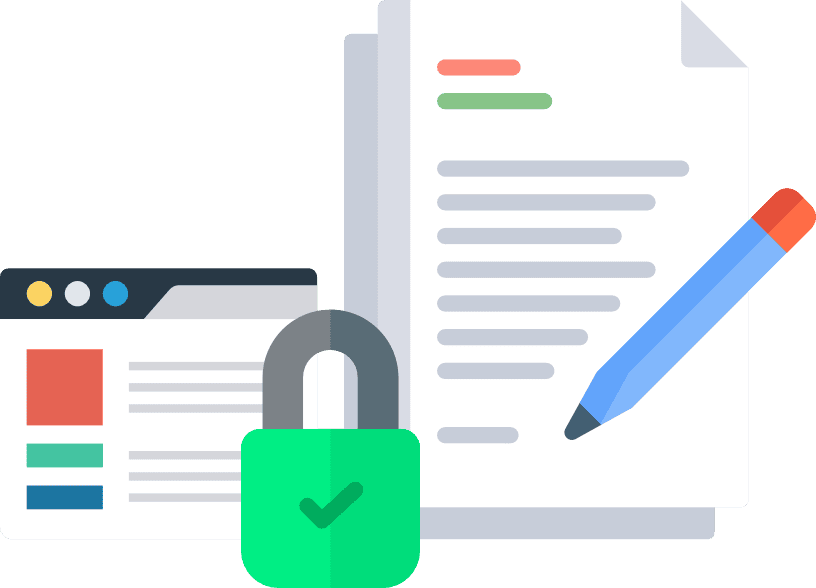A blog is an essential tool and serves many purposes, an expression of creativity, a way to connect with clients, to establish yourself as an authority, or simply for marketing your product.
While creating a blog, you’d likely concentrate on the niche you want to write about, the design, the topics, the SEO capabilities, the technicalities, and how to market it.
However, one thing that many bloggers forget is how to establish trust with their readers. This is why having terms and conditions for your blog is not just very important but quintessential for your blog.
As a blog owner, you want your readers to interact and recommend you to others, and your reader needs to know the rules so they don’t accidentally do something they’re not supposed to.
In this article, we will discuss the benefits of having terms and conditions and how to draft them so that you can confidently display them on your blog.
Table of Contents
PRO TIP: Take the hassle of writing your own terms and conditions away with our terms and conditions generator trusted by over 200,000 businesses. It’ll save you hours of work and possible costly legal mistakes.
What are Blog Terms and Conditions?
A blog’s terms and conditions is an agreement containing the rules and guidelines you want your readers to follow when accessing your blog pages.
These can include things such as user behavior, commenting, sharing of content, and other house rules that you may want to specify based on what you offer on your blog.
Having these in place can help to keep your blog running smoothly and help avoid any unwanted legal headaches.
Why Does Your Blog Need Terms and Conditions?
Having terms and conditions on your blog can benefit you in a number of ways.
- Helps to set expectations for your readers: Your readers will know what they can expect from your blog, and what kind of behavior is expected of them. This can help to avoid misunderstandings and keep everyone happy.
- Legal coverage: If something goes wrong on your blog, or if someone sues you, having terms and conditions in place can help you legally defend yourself.
- Intellectual property rights protection: In case someone copies your blog’s logo, design, images, or content, you’ll have the legal power to pursue monetary damages.
- Professional appearance: Legal stuff makes you look serious which can ultimately lead to more readership and success for your blog.
Of course, there are other benefits attached to having terms and conditions, but these, as a rule, should be sufficient to motivate creating the terms sooner rather than later.
Are Terms and Conditions Legally Required for Your Blog?
No, terms and conditions agreement is not a legal requirement for a blog. However, it is highly recommended as a protective measure.
As mentioned earlier, as a blog owner you want to make sure you’re protected from malicious users, intellectual property theft, any product, service, or content-related liability, and more.
In case there is a lawsuit against you, the court or governing bodies will take a look at your blog terms and conditions which may determine the outcome of your case.
This will help them mitigate any dispute or complaint filed against you. This is why these terms need to be created properly so that they hold up in court.
What Should You Include in Your Blog’s Terms and Conditions?
While there are obviously many things you can put into your terms and guidelines, you would normally base them on how you operate your blog and what it offers, for example:
- If users can create an account
- If users can post or create and publish their own content
- If you allow users to interact with each other
- If you sell anything or accept payments
- If you offer certain types of sensitive content
- If you offer any type of newsletter or subscription
- And more
Let’s take a look at a few clauses that you’ll typically want to include in your policy.
Accuracy of Information
For any content that you decide to publish on your blog, accuracy is important because it helps you to build trust with your readers.
Unfortunately, we’re not robots so it’s in our nature to sometimes make mistakes. You want your readers to be aware of it and take some of that liability off yourself in case you make a typo.
Acceptable Behavior
One of the tools that one may use as a blog owner is to build a community through regular interactions. A community should be a safe space for everyone to foster sharing of opinions, thoughts, and ideas without feeling any negative emotions.
As a blog owner, it falls on you to define what is acceptable and what is not within your community. Here are some elements to consider when drafting the document:
- Using offensive language such as abusive words
- Targeting someone for their beliefs, ethnicity, a physical or mental condition also known as hate speech
- Impersonating someone else or pretending to be someone you are not
- Stalking and harassing someone
- Posting objectionable content in comments
- Sharing other user’s personal information online
It is also a good idea to make sure that you clearly mention what actions will be taken against the perpetrator.
You may expand the list of what’s acceptable on your blog and what’s not by creating a dedicated acceptable use policy.
Limitation of Liability
Whether you are selling a service, or a product or providing information on your blog, you need a way to limit your liability if there is a breach, an error, or a product or service-related issue.
You need a way to let the user know that if the following happens, you as the blog owner cannot be held responsible:
- Your blog is unavailable: If somehow your site is down and your readers are unable to access any information, personal or public, you are not responsible. This is especially important if you offer something on your blog that people expect to have access to at any time.
- Failure to moderate comments: You may be held liable if you fail to moderate comments and allow offensive or defamatory statements to remain on your blog. This is why you need a content moderation system in place but having a related clause in the terms will help as well.
- Content published is inaccurate: As mentioned above, we sometimes make mistakes. You want to let readers know about it before someone decides to sue you for incorrect information that may have led to poor or unexpected results.
- Errors of any kind on the website: Data theft happens more often than we’d like. In many cases, we don’t even have any control over it as it happens outside of our reach. You may have the most secure blog in the world but if your hosting provider falls victim to an attack, there’s not much you can do about it.
Copyright
Whether you publish content yourself or let your readers post theirs, you need a clear policy that ensures everyone is aware of who is the copyright owner and how the intellectual property is handled. You wouldn’t want anyone claiming your work as theirs down the line so it’s important to explain everything.
Examples of Blog Terms and Conditions You Can Learn From
We’ve put together a list of terms and conditions examples you could use as inspiration when writing your own.
Marie Forleo
Marie Forleo is a very successful life coach. In her blog’s terms and conditions, she has set a good example of outlining each and every point that may affect her and her readers. She has specifically mentioned various ways in which community violations may occur, which is important and will help deter blog visitors from acting irrationally.
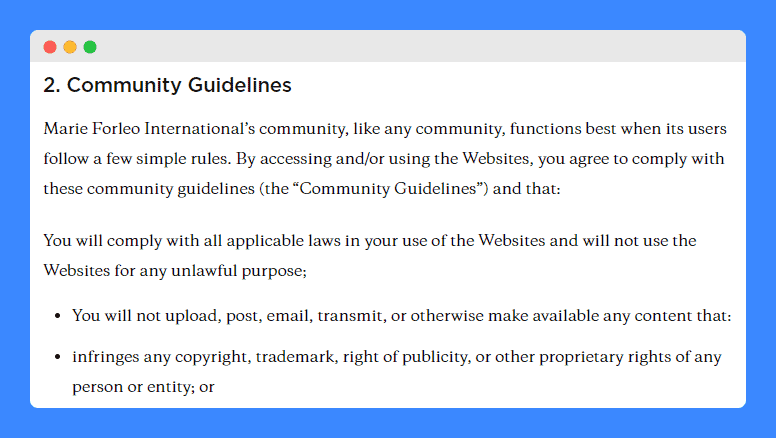
Lauren Toyota
Lauren Toyota is a lifestyle influencer and creator of “Hot for Food”. Her blog is aimed at gourmet-vegan enthusiasts and she has ensured that her readers and followers are aware of what third-party websites and content mean in relation to her blog.
In short, it’s not her responsibility to check third-party websites or content and readers should be aware of that if they choose to click and follow any of her links.
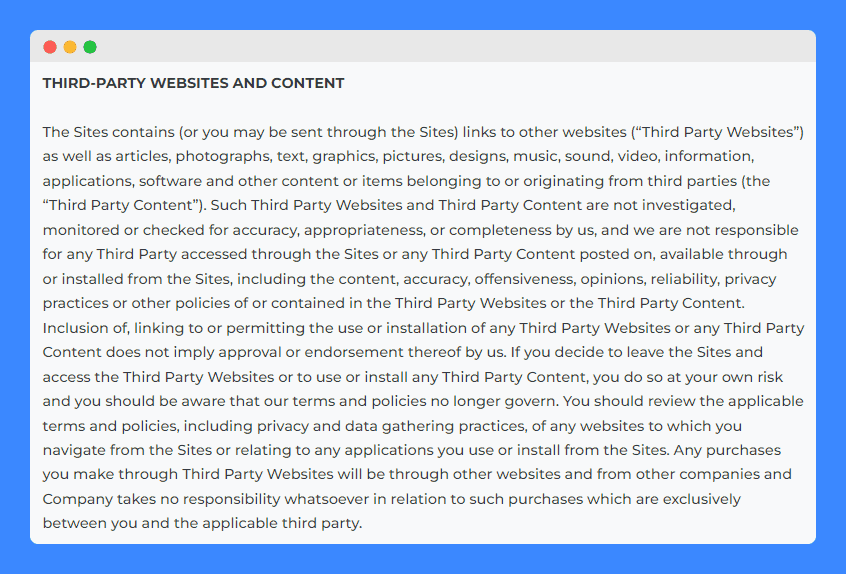
Heather Stammen
Heather Stammen, a Chicago-based health blogger and trainer, started Dumbbell Blonde to share her journey and influence women. She makes sure to specify that there may be errors on her website or it may not even be up to date. Of course, it may not be her intention to leave outdated articles online, but it may happen.
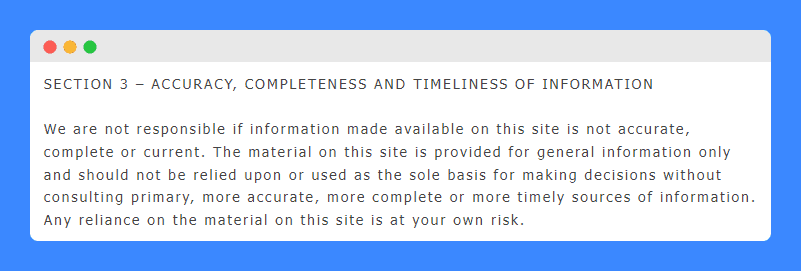
Sample Terms and Conditions Template for a Blog
If you decide to write your own terms and conditions for your blog, you may use this sample template as a starting point and personalize it to your needs. Of course, it’s best that you add clauses depending on how you operate your blog to ensure proper legal coverage.

How to Write Terms and Conditions for Your Own Blog?
Hopefully, by now you probably know how important it is to have terms and conditions. But what should this agreement say? Well, it largely depends on what you offer on your blog and how you operate it.
For example, a marketing expert might want to promote themselves and be established as an industry expert, while a writer might simply want to build a community and foster positive interaction with readers.
This is why the terms for your blog should reflect that and not be too generic. Here are some tips to help you write terms and conditions for your own blog:
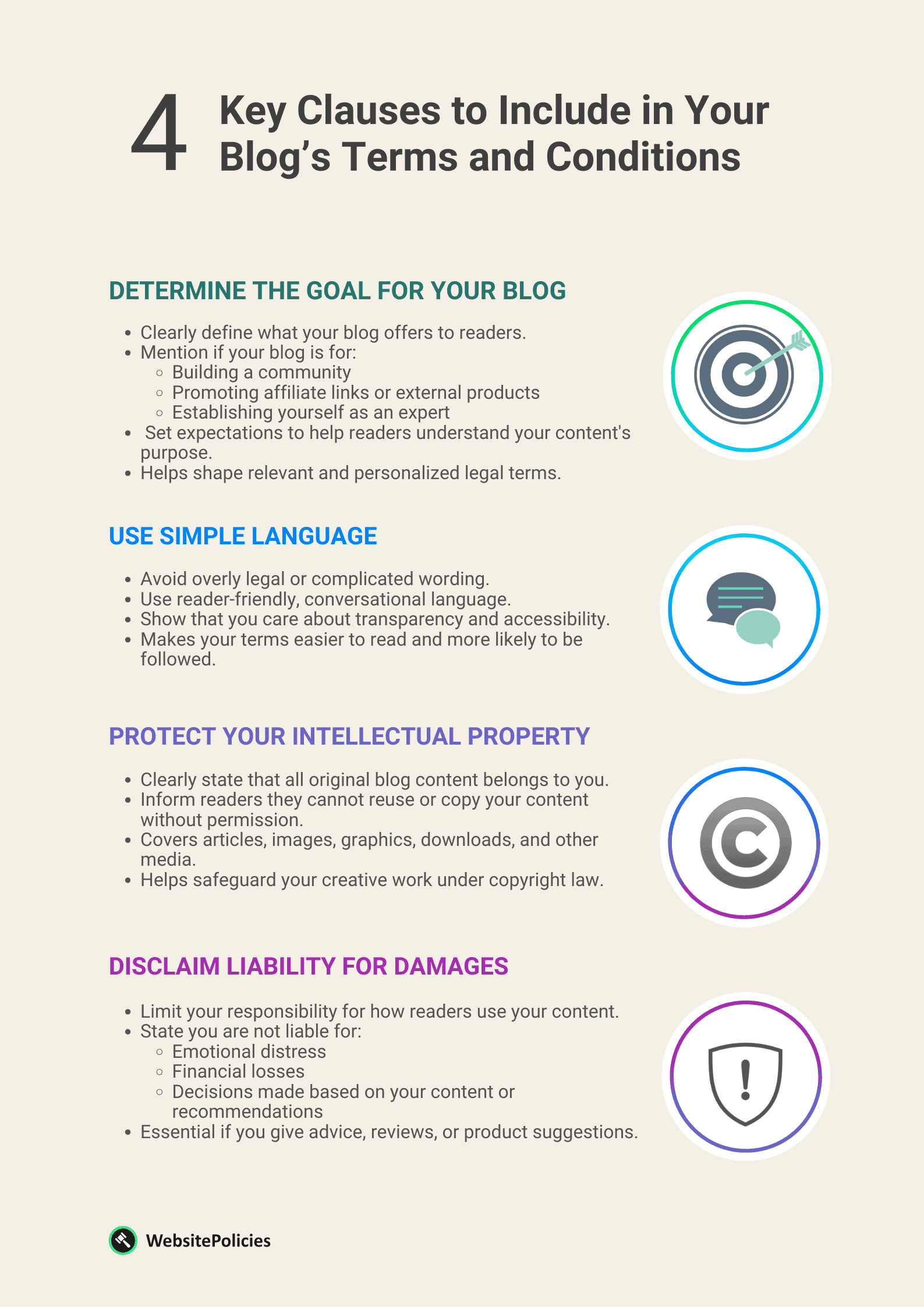
Determine the Goal for Your Blog
Be clear about what you offer. Your terms and conditions should make it clear what content or services you provide on your blog. This will help set expectations for your readers.
Ask yourself what your purpose for blogging is, for example:
- Are you creating a community?
- Are you trying to send people to other websites?
- Are you trying to be an influencer or an industry expert?
How does this matter? A writer building a community should be more focused on creating a safe space for their followers, while an influencer promoting a product or a service should limit their liability.
Use Simple Language
One of the reasons that the terms and conditions documents are commonly ignored is the complicated language used in them. It is impersonal and does not really say that you care about your readers.
Simplifying the language it will help your readers understand your blog’s house rules and follow through with them.
Protect Your Intellectual Property
If you create original content on your blog, you’ll want to make sure it’s protected by copyright law. Your terms and conditions should include a statement that says all content on the site is owned by you and may not be reproduced without permission.
Disclaim Liability for Damages
One of the ways in which a blogger can get into legal trouble is if a reader claims any kind of financial loss, mental damage, or distress resulting from either following advice posted on your blog or buying a recommended product.
This is where a disclaimer clause comes in order to limit your liability and protect yourself from frivolous lawsuits.
Create Terms and Conditions using WebsitePolicies
Take the guesswork out of the legal jargon with our smart generators & create terms and conditions personalized to your needs in minutes. Here’s how:
Step 1: Navigate to the terms and conditions generator.
Step 2: Answer some questions about your business and how you operate.
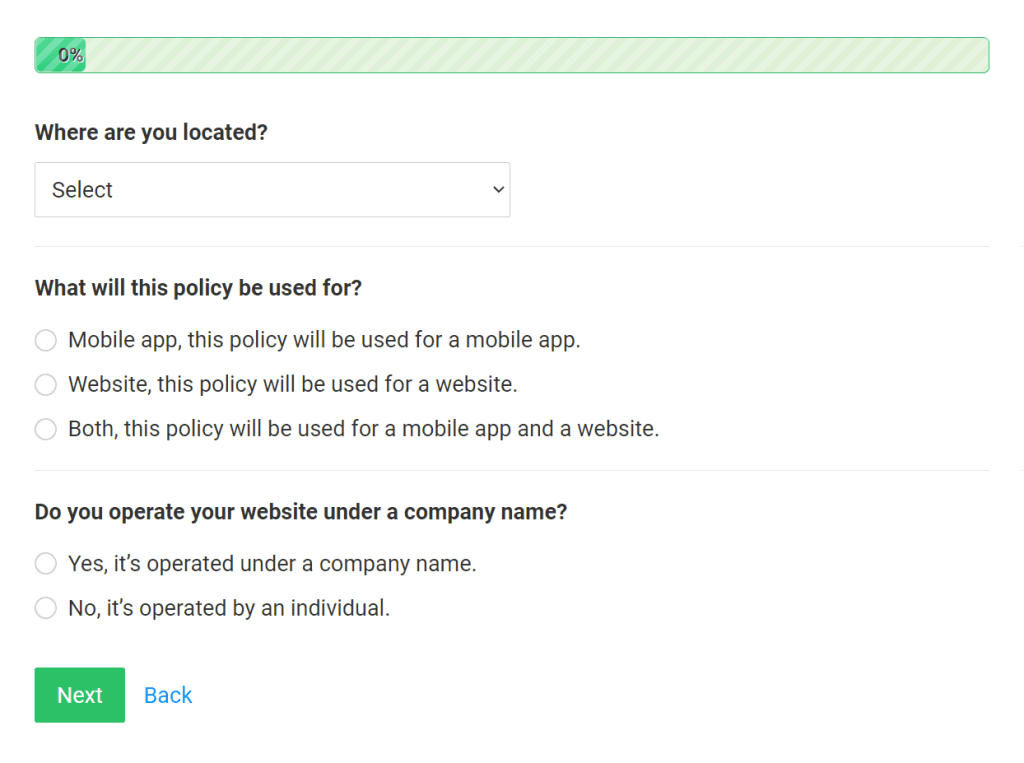
Step 3: Create an account and publish or copy your personalized terms and conditions.
Create Your Terms and ConditionsFrequently Asked Questions
When is a terms and conditions agreement necessary for your blog?
It’s best to create it right away along with all other essential legal policies your blog should have. This will ensure legal coverage and peace of mind from the start.
Can I write my own terms and conditions?
Yes, you can write your own terms and conditions. However, it is important to make sure that they are legally binding and compliant with all applicable laws by writing the agreement correctly.
Where should you place terms and conditions on your blog?
The most common way is to create a dedicated page for the terms and conditions agreement and insert a link to it in the footer of all pages of your blog.

